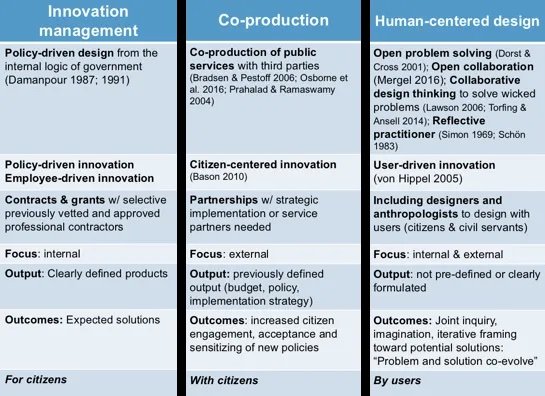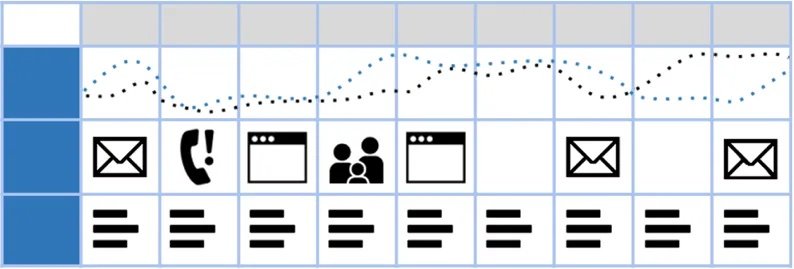Unit 4
How Ines Mergel teaches Unit 4
What is this page?
This is a detailed breakdown of how Professor Ines Mergel from the University of Konstanz teaches a class that covers the contents of Unit 4 of the open access syllabus developed by Teaching Public Service in the Digital Age.
The official designation of the course Professor Mergel is teaching here is "MA Seminar: Digital Governance".
We believe it is helpful to see how professors in different contexts teach the same concepts, so to see a class breakdown from the US see here, and to see one from Brazil see here.
Who is this page for?
This page has been developed for use by university faculty who are teaching Master's levels students in Public Policy and Public Administration. It has been published to help them design their own approaches to teaching the digital era skills covered in Unit 4 of our syllabus.
Class Overview
This class section introduces students to the concept of human-centric design both as a new work practice as well as a general attitude toward inclusion of all users in the digital service design process. In order to make the content relevant to public administration students, the class starts with a review how public administrators have been using design approaches in the past and what the design elements are that are usually designed by them. The students then learn about human-centric design as a concepts, its values and methods. This approach is contrasted to existing approaches and experiences the students have when they interact with public administrations - they derive the administrative burdens they have encountered themselves. They subsequently apply these methods to an administrative process that they know (applying for financial aid/student loans) and develop a prototype of a user-oriented process (on paper).
This Class' Learning Objectives
By the end of this class students should be able to:
Enumerate the ways that bad design harms citizens by increasing administrative burdens.
Identify different types of users
Apply basic steps of user-centered design (for example, a user journey)
How this class relates to the Digital Era Competencies
💡 This class has a specific focus on Competency 1 - Users. See all eight competencies here.
Assigned Reading
Bason, C. (2018). Leading Public Sector Innovation 2E: Co-creating for a Better Society. Policy press. Chapter 7.
Eisenmann, T. R., Ries, E., & Dillard, S. (2012). Hypothesis-driven entrepreneurship: The lean startup. Harvard Business School Entrepreneurial Management Case, (812-095).
Moynihan, D., Herd, P., & Harvey, H. (2015). Administrative burden: Learning, psychological, and compliance costs in citizen-state interactions. Journal of Public Administration Research and Theory, 25(1), 43-69.
Romme, A. G. L., & Meijer, A. (2020). Applying design science in public policy and administration research. Policy & Politics, 48(1), 149-165.
Detailed Class Breakdown
Class plan: 90 minutes
The sections below describe the dynamics of each part of the class:
Segment 1 - Introduction: Public administration as a design science - 15'
In this brief opening lecture, instructors should explain that design is not a new activity for governments. Public administrations have been designing a wide variety of different ‘things’ for a long time:
Policies
Models of the environment (Simon 1988)
Organizations
Processes
Interactions, relationships, behaviors
Forms, signs, buildings
Digital products and services
Segment 2 - Discussion: Let’s talk about what happens when government design is bad! - 10'
The purpose of this segment is to encourage students to think about the impact of low quality government service design by reflecting on their own lives, or the experiences they have seen or read about elsewhere. The discussion can be in a single shared group, or breakout groups depending on how many students are in the session.
What are your experiences of government services or policies that don't seem to have been well designed?
Why does bad design harm citizens? What sorts of harms result from failures to design properly?
Segment 3 - Lecture: User-centered design (definition, framework)
The purpose of this segment is to introduce students to the idea that there are a set of methods and ideas for designing both products and services well - in ways that meet user needs and produce experiences that are easy, attractive and accessible.
Focus on user engagement
Human experiences
Human interactions
Goal: Improve processes, decision making, user satisfaction, and loyalty/usage.
Design-oriented approaches (e.g., use of generative tools for visualization) (Sanders 2000).
Research-oriented approaches, e.g. applied ethnography & qualitative user surveys (Portigal 2013).
User-centric design focuses on four different aspects: a mindset (such as designing for citizens), general principles that embody the mindset (such as digital first), certain practices through which the principles are enacted (such as scaling up), and techniques that support the practices and mindset (such agile project management). The following graphic summarizes what user-centric design looks in practice:
Segment 4 - Lecture part II: Relate human-centricity and user-centered design to the co-production literature in public administration - 15´
The purpose of this segment is to help students understand that whilst design practices come from the professional design community, they are connected to practices that have emerged from inside the public administration field itself.
In this section instructors should inform students in a lecture that there is a long history of different ways on how users are integrated into the work of public administrators (either mandated by law or on a voluntary basis). The following slides summarizes the three literature streams and the ways that public administrations are designing new products and services:
Segment 5 - Exercise: Conduct a user journey -15'
Using a version of GDS' design template for a user journey, the students are instructed to conduct a user journey of application process for a student loan (Bafög). They are identifying the types of interactions with agencies and other organizations related to the process (tax administration, health insurance, etc.), insert the types of forms, data and documents they need in every phase, the medium they are using (or potentially have to switch to) and record their emotions along the way:
Source: https://designnotes.blog.gov.uk/2016/04/21/how-to-make-a-user-journey-map includes a table that shows the steps a user takes to get access to a public service including type of technologies, emotions, experiences during each of the steps.
Instructors should then show students the following video on how co-creation and user-centricity have made a difference in service design:
How can you get support teaching this unit?
We're dedicated to helping make sure people feel comfortable teaching with these materials.
Send a message to mailbox@teachingpublicservice.digital if you want to book in a call or have any questions.
What are your rights to use this material?
We have developed these materials as open access teaching materials. We welcome and encourage your re-use of them, and we do not ask for payment. The materials are licensed under a Creative Commons Attribution 4.0 International License.
If you are using any of our syllabus materials, please credit us on your course website using the following text:
We are proud to use the Teaching Public Service in the Digital Age syllabus in our curriculum and teaching. Developed by an international community of more than 20 professors and practitioners, the syllabus is available open-source and free at www.teachingpublicservice.digital
Why was this page created?
This teaching material forms part of the Teaching Public Service in the Digital Age project. Read more about it here.
Acknowledgements
David Eaves would like to note that this material was made possible by numerous practitioners and other faculty who have generously shared stories, pedagogy and their practices. David is also grateful to the students of DPI 662 at the Harvard Kennedy School for enriching the course and providing consent to have the material and questions shared. Finally, an enormous thank you must be given to Beatriz Vasconcellos, who helped assemble and organize the content on this page.




